by Alice Hoi-kei Chung and Nicky Wai-ping Chan

We became like a pair of twins after coming over to the United States. This fact definitely has been witnessed by many people. There is a rumor that we haven’t been apart from each other for more than 12 hours, although we don’t live in the same dorm building. Therefore, this article is written by us together, because we really cannot split up our exchange experience.
We were so excited when offered the chance to study abroad for a whole semester. And this is when we first knew each other. We knew it would be a great experience, and now we have to say it is greater than expected!
There are so many “FAQs” that we have answered a million times. “How do you like Delaware?” should be on top of the list. The answer is always, “We like it.” Many people say that Delaware is boring to live in. But we don’t feel the same way, although the entertainment is not as diverse as in Hong Kong. We do grasp every chance to travel around, having been to Washington D.C., New York City, Orlando, Miami, etc. After this semester, we will visit California and Europe. We are also active members of the Chinese Cultural Student Association, in which we have met a lot of good friends. So how can we be bored when the schedule is so tight?
We also feel so grateful about this Nicky-and-Alice match — a perfect travel match like this is the key to a fun and enjoyable life here. Many people wonder why we, as fashion students, didn’t choose to study in fashion cities like London or New York City, but here in Delaware instead. To be honest, UD was not our first choice. But now we realize that the two of us might have gained so much more than our classmates who went to those cosmopolitan cities. Because of the slower pace of living and so-called lack of entertainment, people can spend more time hanging out together. We guess that is why we could make friends with many locals. For the past three months, we learned English slang from them, we made apple pie and brownies with them, we went to house parties with them, we played Apples to Apples with them, and we also taught them Chinese. Hey, this is what we call cultural exchange!
Luckily, the workload of the classes here is lighter. This allows us to really enjoy the process of studying. We always discuss our schoolwork together as we take the same classes. When we have problems with English, we seek help from our “language partner” friends. We seldom do this in Hong Kong. One benefit you might never have thought of in being away from your home country is you actually learn more and think more — sometimes it is just impossible to find time to do this in the razzle-dazzle of daily life, right? And we must mention that our favorite class here is Global Economics for the Fashion Industry, which inspired us about the need to have a global vision. Professor Jill has great insight into the industry, and we learned a lot from her. More importantly, she’s our best travel adviser!
We are so happy to hear that a UD student is going to exchange in Hong Kong next year. We believe she’ll have so much fun and learn a lot like we have. And we truly believe that a one-semester foreign life experience would be unforgettable and meaningful for anyone. Just like ours!
by Cody Higgins

My experience in Hong Kong has been remarkable, to say the least. My intentions for participating in an exchange program such as the one offered through the Hong Kong Polytechnic University were to further my knowledge of business practices in the fashion industry, chiefly in the fields of product development and production, and specifically supply chain management, as well as to incorporate the cultural lifestyle of various ethnic backgrounds and infuse them into my Western practices and ideologies. Interacting with various people in Hong Kong — including guest speakers such as business leaders, fellow students, and workers from many different manufacturers and textile mills — has expanded my knowledge of the textile industry in ways I would not normally be able to experience first-hand in the States.
Most, if not all, of my professors have been in the industry for at least two decades, and they were always willing to go the extra mile for any exchange students who were interested in going beyond conventional teaching methods and textbooks, even if it meant taking us to the finishing plants themselves. Also, the university is home to a program focused on social responsibility, much like the University of Delaware. Again, seeing practices first-hand that may not adhere to major standards in the garment industry has made me realize that in less than two years time I may be faced with ethical sourcing questions as well as many pressing environmental issues.
Although most of my studies were in the Department of Textiles and Clothing, I was also offered a class in Mandarin. Since I plan to do a lot of work in East Asia, this is vital to know. I was grouped with 20 or so other exchange students and was taught elementary, yet very useful, Mandarin Chinese. As I mentioned previously, much of the knowledge I gained was not limited to the classes I took. The majority of it came through interacting with the 200 or so other exchange students from all over the world, as well as mainland Chinese students and local Cantonese students. I like to think that I soaked up a little bit of the culture of everyone I met and now feel like I have traveled the whole world, even though Hong Kong is the first place I have been outside the States. Everyone is here for the same reason — to learn. Being around such intelligent and creative people is motivating, even more so because I will most likely be working with some of them in years to come, whether it be for advertising, designing, or sourcing purposes. If I had merely come to network, I certainly would have filled that purpose.
The whole journey forced me out of my comfort zone but allowed me to learn a lot about myself and realize the many facets of the textile industry that I never knew existed. Of course, I had my reservations before coming here, but I would stay another year if I could. Hong Kong is a unique place in that it encompasses so many varying entities and types of people, which I never would have come by in Delaware or even New York for that matter.
by M. Jo Kallal

The 2007 International Apparel Federation World Apparel Convention in Taiwan highlighted the rapidly "changing dynamics of apparel production and consumption” that make it imperative to remain updated on the various sectors of “global” product development. As part of the University of Delaware’s Department of Fashion and Apparel Studies’ (FASH) efforts to further internationalize its design and merchandising programs, department faculty traveled to several countries in Asia that are predominant locations of U.S. apparel product development and sourcing — regions where our alumni will travel when they enter the workforce. The faculty’s goals included (a) initiating relationships with education, industry, and nonprofit agencies, (b) becoming more familiar with Asian culture and business factors that impact the international textile and apparel industry, and (c) collecting data to integrate into fashion courses.
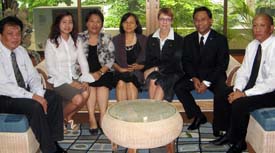 The apparel design and product development process is a system of integrated steps and procedures implemented to develop a company’s seasonal concepts, lines, and subgroupings. A process of prototyping and editing leads to final definitions of each product’s styling and specifications. The steps are both synchronous and asynchronous. In addition, the process may originate from a manufacturer or a retailer developing private-label collections. The large number of individuals, businesses, suppliers, countries, regions, and technologies further complicate the system and subsystems involved. It is these interactions that McCall
and Hollenback use to define a “global job” as one that “requires crossing
borders…borders of country (a proxy for culture) and borders of business
(e.g., marketing, research, product lines, SBUs).” They also note that “lessons
of culture” differentiate education at home from education taking place in
the global arena. Thus, a vital part of learning about global product development
is to internalize awareness of other cultures, traditions, and values.
The apparel design and product development process is a system of integrated steps and procedures implemented to develop a company’s seasonal concepts, lines, and subgroupings. A process of prototyping and editing leads to final definitions of each product’s styling and specifications. The steps are both synchronous and asynchronous. In addition, the process may originate from a manufacturer or a retailer developing private-label collections. The large number of individuals, businesses, suppliers, countries, regions, and technologies further complicate the system and subsystems involved. It is these interactions that McCall
and Hollenback use to define a “global job” as one that “requires crossing
borders…borders of country (a proxy for culture) and borders of business
(e.g., marketing, research, product lines, SBUs).” They also note that “lessons
of culture” differentiate education at home from education taking place in
the global arena. Thus, a vital part of learning about global product development
is to internalize awareness of other cultures, traditions, and values.
Although the steps followed to design and develop apparel are similar in different regions, professional business processes and timing may differ. In addition, cultural influences impact color, material, styling, and fit options. As incomes in some developing countries begin to increase, new business opportunities open up. U.S., Asian, and Central and South American designers and product developers are becoming challenged to create desirable products for new domestic markets and for export to consumers with lifestyles unlike their own. Building upon my background in design and product development, I plan to design and produce learning modules that will infuse global examples, including those from my recent visit to Thailand, into pertinent components of existing FASH courses.
Thailand, a country slightly smaller than Texas, is known for producing high-quality apparel and footwear products for U.S. manufacturers and retailers such as Patagonia, J.C. Penney, and Nike. Thai manufacturers produce special items that may require higher skill levels and are too difficult for other countries to produce. Because they accept smaller lot sizes than other Asian countries, small to medium-size retailers may find Thailand to be a source for creating their own labels. The Thai industry covers the breadth of production from manufacture of synthetic fibers, to the spinning, weaving, knitting, bleaching, dyeing, printing, and finishing of the fabrics. In addition, apparel, footwear, and household textiles are manufactured. Ten percent of Thai companies employ more than 1,000 people; 40 percent employ 200-999 people; and 50 percent employ less than 200 (www.just-style.com). Many large Thai companies are vertical in operation, producing yarns, fabrics, and garments. Most manufacturers are conveniently located in the vicinity of Bangkok, Thailand’s capital. There appears to be less employee turnover because workers at many companies stay for 10, 20, and 30-plus years.
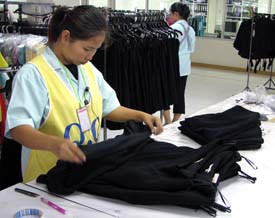 A visit and meeting with the managing director, owners, and designers of Junior Garment Company, a Thai branded company, provided a comprehensive overview of the company’s target market and lines, as well as the design and development of these products. Their openness and willingness to share time and expertise provided me with many images and notes to document the product development process. Other areas visited in the factory included quality control, packaging, and shipping. In a follow-up conversation after the tour, potential growth markets were discussed, as well as U.S. approaches to design and product development. A few key fashion pieces from the designers’ lines were highlighted and appraised in greater detail. I look forward to sharing visual content about Junior Garment Company’s process with our students.
A visit and meeting with the managing director, owners, and designers of Junior Garment Company, a Thai branded company, provided a comprehensive overview of the company’s target market and lines, as well as the design and development of these products. Their openness and willingness to share time and expertise provided me with many images and notes to document the product development process. Other areas visited in the factory included quality control, packaging, and shipping. In a follow-up conversation after the tour, potential growth markets were discussed, as well as U.S. approaches to design and product development. A few key fashion pieces from the designers’ lines were highlighted and appraised in greater detail. I look forward to sharing visual content about Junior Garment Company’s process with our students.
Patagonia, a U.S. company, has built long-term relationships with several Thai companies. When the first organic cotton initiative was launched in 1995, few companies understood the term “organic." Thai Alliance Textile Company met the challenge of locating organic cotton and meeting Patagonia’s product specifications. Siam Knitwear and Garment Company and Thanulux Public Company Ltd. are other major manufacturers that built strong working relationships with Patagonia to develop new fabrications and products. These partnerships, along with Patagonia’s strong reputation, influenced other high-quality manufacturers to conduct business in Thailand (www.patagonia.com/web/us/footprint). Thai Alliance Textile received a National Award as Outstanding Establishment for labor relations and welfare.
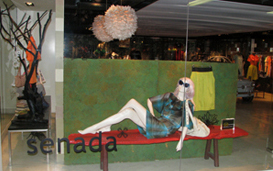 Guided visits to view Bangkok’s retail venues provided showcases for comparing Thai brands with corollary European, Japanese, Korean, Chinese, and American lines. Bangkok’s numerous high-end fashion malls and shops are in close proximity to the Fly Train stops.
Successful Thai fashion designers showcase their lines in unique, boutique-style shops in the many shopping malls. In nearby neighborhoods, small, trendy boutiques run by lively and experimental designers show the creative promise of Thailand’s young innovators. A few examples of clothing brands include Greyhound, Senada, Flynow, and Jim Thompson. Several Thai fashion brands would appeal to young American consumers. Special sections in malls, department stores, and markets featured traditional Thai handcrafted products displayed according to the targeted market and venue.
Guided visits to view Bangkok’s retail venues provided showcases for comparing Thai brands with corollary European, Japanese, Korean, Chinese, and American lines. Bangkok’s numerous high-end fashion malls and shops are in close proximity to the Fly Train stops.
Successful Thai fashion designers showcase their lines in unique, boutique-style shops in the many shopping malls. In nearby neighborhoods, small, trendy boutiques run by lively and experimental designers show the creative promise of Thailand’s young innovators. A few examples of clothing brands include Greyhound, Senada, Flynow, and Jim Thompson. Several Thai fashion brands would appeal to young American consumers. Special sections in malls, department stores, and markets featured traditional Thai handcrafted products displayed according to the targeted market and venue.
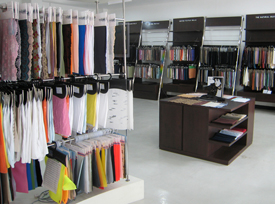 Thailand’s 2005 Project, directed at growing its international fashion image, continues to make headway. Initiatives exist for companies to develop original designs and brands for export in the region and to North America. The newly established Fashion Knowledge Creation Center supports the fashion industry by making the most recent trend books, fashion reports, and textile product offerings from major vendors accessible to professionals in one central location. The center also displays traditional Thai textile products produced from Thai silks and other handcrafted materials.
Thailand’s 2005 Project, directed at growing its international fashion image, continues to make headway. Initiatives exist for companies to develop original designs and brands for export in the region and to North America. The newly established Fashion Knowledge Creation Center supports the fashion industry by making the most recent trend books, fashion reports, and textile product offerings from major vendors accessible to professionals in one central location. The center also displays traditional Thai textile products produced from Thai silks and other handcrafted materials.
Thailand’s textile and apparel industry includes both fast and slow fashion systems. Faster fashion was previously discussed. Slow fashion is a new system that focuses on creating specialized meaningful products. Custom-fitted and tailored apparel draws global travelers who want to take advantage of the impeccable quality in fabrication, fit, and workmanship. Handcrafted products are another illustration of slow fashion.
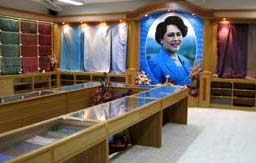 In addition to the production of contemporary textiles and apparel, Thailand continues to develop programs designed to sustain its traditional handcrafted products. One mission known as the Queen’s Silk Project, focuses on reviving and sustaining traditional textile production techniques in villages throughout Thailand. Another program, OTOP, “one tambon (village), one product,” provides training and management skills to one village at a time. A goal is to enable villages to support themselves via specialized products. Some villages provide natural dyeing and weaving demonstrations to tourists while others produce cotton and silk cloth for retail and wholesale. Training programs such as those at the Thai Silk Museum and Development Center and the world-renowned Population and Community Development Association near Kohn Kaen in Northeast Thailand facilitate training in sericulture, spinning, dyeing, weaving, and management skills to support the local cottage industry. Earnings from the sales of silk douppioni yardage and products supplement the development centers’ income, allow for the purchase future production supplies, and provide salaries to the workers. As they are able, some workers purchase silk worms for sericulture farming. I returned to Delaware with samples of three different hand-dyed and hand-woven lengths of Thai silk. Another textile-related tradition is the hand mixing and dyeing of cotton using natural dye baths. The Community Development Center also provided production facilities for footwear and apparel. One area of need is assistance in selecting and designing apparel and accessory products using traditional materials that will appeal to tourist and export markets.
In addition to the production of contemporary textiles and apparel, Thailand continues to develop programs designed to sustain its traditional handcrafted products. One mission known as the Queen’s Silk Project, focuses on reviving and sustaining traditional textile production techniques in villages throughout Thailand. Another program, OTOP, “one tambon (village), one product,” provides training and management skills to one village at a time. A goal is to enable villages to support themselves via specialized products. Some villages provide natural dyeing and weaving demonstrations to tourists while others produce cotton and silk cloth for retail and wholesale. Training programs such as those at the Thai Silk Museum and Development Center and the world-renowned Population and Community Development Association near Kohn Kaen in Northeast Thailand facilitate training in sericulture, spinning, dyeing, weaving, and management skills to support the local cottage industry. Earnings from the sales of silk douppioni yardage and products supplement the development centers’ income, allow for the purchase future production supplies, and provide salaries to the workers. As they are able, some workers purchase silk worms for sericulture farming. I returned to Delaware with samples of three different hand-dyed and hand-woven lengths of Thai silk. Another textile-related tradition is the hand mixing and dyeing of cotton using natural dye baths. The Community Development Center also provided production facilities for footwear and apparel. One area of need is assistance in selecting and designing apparel and accessory products using traditional materials that will appeal to tourist and export markets.
After the modules are developed, I hope to initiate an apparel product development project among Thai and U.S. students to afford them an opportunity to communicate and learn from one another. Such endeavors can lead to better understanding from both Asian and Western perspectives, which may lead to improved business relationships by future industry professionals.